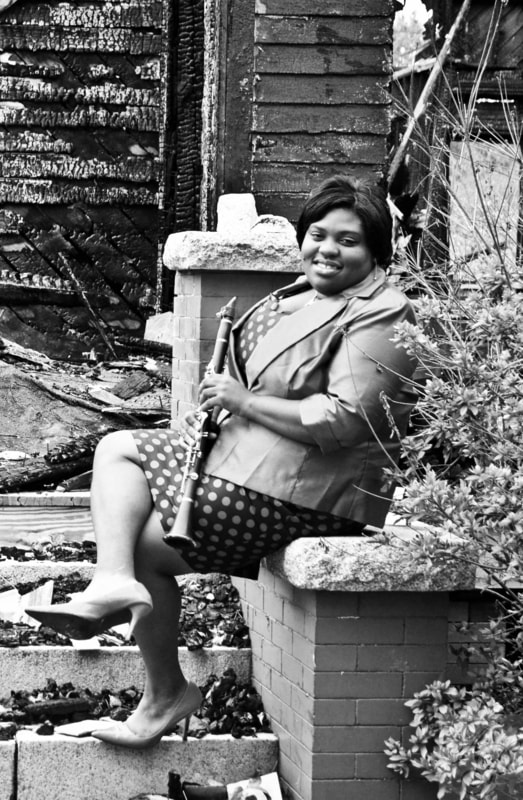|
Today's BIBA is a feature of an incredibly gifted, young composer: Brittany J. Green! Ms. Green's music and research includes technological interests and creating musical spaces that focus on the "intersection between sound, movement, and text." Her work has been presented at the 2019 SCI National Conference, NYCEMF, the BGSU Graduate Conference, the West Fork New Music Festival, the Darkwater Women in Music Festival, and the Intersection@Art and Science Symposium at East Carolina University, among others. Ms. Green has recently announced she will be pursuing a PhD in Composition at Duke University this fall! Congratulations on this recent announcement and best wishes!! BIBA : How did you get into this crazy world of contemporary classical composition?
BJG : I have always been a curious person and I’ve always had an interest in creative expression. As a beginner musician, I immediately took interest in not only learning my instrument, but writing for it. My interest in composition really sparked once I reached high school. At that point, composing and arranging became a regular part of my musical practice. My band director would often allow me to write and arrange pieces for the band to play. Having feedback and validation at such a young age, I think, was important and gave me the foundation and confidence to continue to compose and share my work. I’ve been fortunate to have wonderful teachers, mentors, and support along the way, which I think has helped me walk into the contemporary classical space and feel comfortable sharing my voice. BIBA : What are some of the challenges you have faced or are still facing as your career emerges? BJG : My academic and professional experiences have been inclusive and uplifting thus far, which gives me hope that there is potential for true equity throughout the classical music field as a whole. There are a few glaring issues, however, that I feel need to be addressed immediately before this can happen. One of which is the issue of representation. I think it is unacceptable that Black composers are not integrated in music education, aside from conversations about Jazz and Spirituals. We are not afforded the same privilege of versatility as our non-Black counterparts, and I think this is a true disservice to all students. There are a plethora of engaging, complex, and expansive pieces composed by highly accomplished Black composers that lend themselves to important dialogue about contemporary music and the intersection of race and music. These conversations are missed, to the detriment of students, when we refuse to create inclusive programs and curricula. Furthermore, we cannot address the lack of Black classical composers, conductors, and performers, without addressing the lack of Black representation in classical spaces. BIBA : You recently profiled Black composers daily for Black History Month. Which composers or what informational tidbits did you find the most fascinating in this process? BJG : It has been great learning and sharing that there are and have been many, many prolific Black composers in each musical era, writing in any and every aesthetic you can think of. Black composers have not only existed, but have shaped the history of classical music. Black composers are accomplished, winning Pulitzer, Rome, and ASCAP prizes as well as distinguished grants and fellowships like the Fulbright, Guggenheim, and NEA. Black composers write jazz, spirituals, and commercial music, but they also write sound art and music that is neoclassical, experimental, electro-acoustic, interactive, performative—you name it! I’m glad to play a part, even if it’s small, in showing the world how talented we are and amplifying the voices of these wonderful composers! My hope is that projects like these inspire classical musicians and music educators to program, research, and present more composers of color in the recital hall and the classroom. I’ve also learned about a few new composers that I wasn’t familiar with before and I look forward to continuing to explore their music. BIBA : What are some of your upcoming projects? BJG : This spring is rather busy for me with quite a few upcoming projects and presentations. I am currently working as a teaching artist at Wahl-Coates School of the Arts in Greenville, NC as a part of the inaugural Young Composers Program in Pitt County, NC. The Young Composers Program synthesizes music, science, math, problem solving, team building, technology, creativity, and critical thinking. Students work together to compose a piece of music, thinking creatively about melody, harmony, rhythm, mood, texture, timbre, instrumentation, and form. The program also offers an introductory coding course where students explore Max/MSP and Scratch programming languages in collaboration with Arduino, Leap Motion, and midi controllers to design digital musical instruments and create computer applications for music. In terms of new music, I just completed a work for classical guitar and electronics for the Margins Guitar Collective. We are looking to premiere that work Spring 2019 in Athens, GA. I will also be presenting research on the work of Jennifer Higdon in early March at the Darkwater Women in Music Festival and my piano suite, Portraits will be performed at the 2019 Society of Composers National Conference. Lastly, I have been working on a virtual reality installation piece, The Sound of Color, that generates 3D visuals based on sound frequencies, timbre, articulation, and dynamics. BIBA : I give you the commission of a lifetime, and it is without restrictions. What piece would you create? What forces? Duration? etc ... BJG : I have always been fascinated with the intersection of movement, sound and text. I would love to compose an electro-acoustic piece for Pierrot Ensemble, dancers, statues, and live electronics that explores fixation and fluidity. The piece would feature dancers interacting with statues, with the movement of the dancers generating sound and triggering live sound processing. The interaction between the dancers and the statues would dilute the boundary of still and moving, with the dancers changing the audience’s perception of the stillness of the statues, and at times appearing as continuations of the statues. Similarly, the sound generated from the dancers would then interact with stagnant and pulsating gestures performed by the Pierrot Ensemble. These two sound worlds would weave in and out of one another, changing the perception of the stagnant sounds and at times converging to create a singular sound mass. The piece would be approximately 30 minutes long, broken into several movements, to be experienced by the audience as if they were at an exhibition, moving from one visual art piece to the next. Each movement would be performed in a different room one after the next, with the instrumental performers only visible in the last room/last movement, but audible in all the rooms/movements. ---- Check out Brittany J. Green's website HERE, and follow her on social media! See below: Soundcloud: (Brittany J. Green) https://soundcloud.com/brittany-green-381873684 YouTube: (Brittany J. Green) https://www.youtube.com/channel/UCpahQl5t2bZ23KA3jhmvcgg Facebook: www.facebook.com/greenb Instagram: @brittanyjgreenmusic
0 Comments
Leave a Reply. |
Details
Writings, musings, photos, links, and videos about Black Artistry of ALL varieties!
Feel free to drop a comment or suggestion for posts! Archives
May 2024
|
Member Login
Black concert series and educational programs in Boston and beyond


 RSS Feed
RSS Feed










